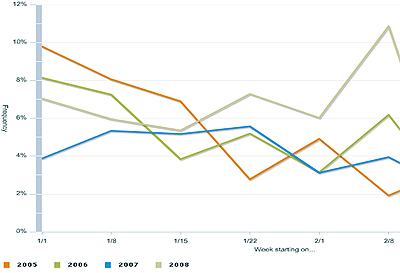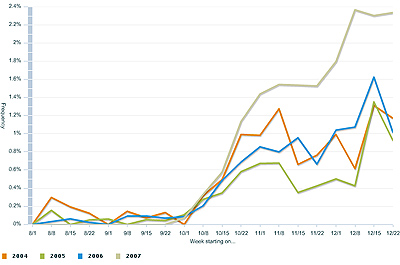
Northern Shrike
So, is anything going on with Northern Shrikes in Wisconsin in 2008 or not? Well, one person thought there was nothing unusual about this year, while another offered that perhaps the entire shrike population shifted south for reasons unknown. Personally speaking, in all the years I've been birding in the Madison area, I've never observed so many shrikes. They're at Governor Nelson, Pheasant Branch, Nine Springs, Middleton Business Park. Even a co-worker of mine had one die from a window collision at her home. I can't recall ever reading about them showing up in backyards and eating suet until this year. Hmm. How about some data?
The most convenient and readily accessible place for me to check for species specific observational data is eBird. I ran a few national reports and nothing looked too out of the ordinary, but when I selected only the state of Wisconsin from January 1st, 2008 to the present, I noticed an interesting frequency increase beginning around late January:

(click graph for larger image)
Perhaps the most interesting thing about this graph is how 2005 and 2008 are practically reverse in this specified date range. Both 2006 and 2007 are very similar years with a gradual frequency decreases, and by January 15th, the year 2005 blends very nicely with those two years. But not 2008. Beginning in late January and early February there is an upward frequency shift.
eBird notes: "Frequency is the percentage of checklists reporting the species within a specified date range and region. This is the most conservative way of displaying the eBird data."
What's the correct interpretation of this data? Darned if I know. As one particular Minnesota birder is so fond of pointing out, I'm certainly no expert. Ryan Brady's southern shift of the entire population for an explanation is appealing, but if so, why did this happen? One wonders if having twice the normal snowfall this winter somehow factors into what appears to be a frequency shift running into early February 2008 when compared with recent years.
Addendum:
Taking a look at 2007 fall migration eBird graph for all states, the Northern Shrike showed a pretty substantial increase in frequency against previous years on record:

(click graph for larger image)
Considering this graph, it seems reasonable to conclude shrikes were on the move before the record snowfalls and definitely supports 2007/2008 as an irruptive season.
From Birds of North America:
"Hypothetically, dependence on sparse and difficult-to-catch prey (small birds and mammals) in wintertime and winter mortality are main factors controlling number of shrikes from year to year, rather than any conditions on breeding grounds. Just how natality, mortality, and dispersal relate to cyclic or irruptive winter occurrence of shrikes remains to be determined (Cade 1967, Davis and Morrison 1988, Cade and Swem 1995)."
Northern Shrike © 2008 Mike McDowell

















